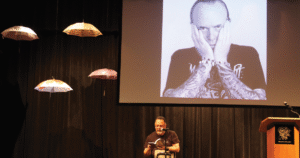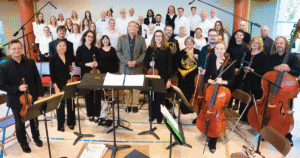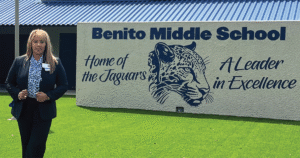
By Celeste McLaughlin
Most middle school students display their science projects in their school’s gymnasium or library and, if they win, maybe at the local convention center. However, two New Tampa residents recently got to display their projects outside of the U.S. White House.
Live Oak Preserve resident Joey Santana, 12, and Sophia Nobles, 11, who lives in West Meadows, recently returned from a trip they say they never could have imagined. They were invited to present the science project they worked on together at the fifth annual White House Science Fair.
The students were invited to participate in the March 23 event because they had previously won second place in a national competition (sponsored by Toshiba and the National Science Teachers Association or NSTA), called “ExploraVision,” which Joey says, “challenges kids to look at modern technology and think about how it will work in the future.”
Their project was chosen as a winner from among 4,962 projects entered into one of the following ExploraVision age groups: K-Grade 3, Grades 4-6, 7-9 and 10-12. A first place winner and second place winner in each age group was selected, and their project earned second place honors in the Grades 4-6 category.
Just days before the science fair at the White House, Joey and Sophia, along with teammate Catie Tomassello, 12, were invited to attend. Unfortunately, Catie and her mom Heather, who served as the team’s mentor, were unable to attend the event. So, Joey, Sophia and their moms flew to Washington, D.C., along with their teacher/coach, Lorna Cohen, who has lived in Pebble Creek for the past 18 years.
The White House Science Fair brings together, “student winners of a broad range of science, technology, engineering and math (STEM) competitions from across the country,” according to a White House media release. U.S. President Barack Obama and senior administration officials, along with invited guests from leading STEM organizations and the media, attended the event and viewed the projects, although President Obama only viewed some of the projects and did not make it to see Joey and Sophia’s.
Their project is called WateRenew, which is an energy-efficient way to desalinate water. “If you look at Florida, there’s tons of water,” Joey says, “but it’s not accessible to drink.”
So, he and his teammates researched and refined their idea until they came up with a model that would work. As part of their research process, they visited a desalination plant in Riverview and interviewed Lee Marcum, owner and chief research and development officer of Clean and Green Enterprises, Inc. (a Melbourne, FL-based company that focuses on finding energy and water usage solutions). Marcum invented the technology called “wave wings,” which rest on the ocean floor and use the natural motion of the ocean’s waves to create electricity. The students’ project uses these 15-foot-tall “wings” to power their desalination process, which uses reverse osmosis filters made from graphene, a one-atom sheet of carbon with tiny holes that measure just one nanometer across. Potable water passes through this filter, leaving the salts behind.
“It would cost a lot of money to build, but it would be worth it, because it would save lives,” Joey says. “I’ve heard about droughts in California, and it could be used there, or in Africa, or basically anywhere that is on a coast.” Joey, Sophia and Catie built a prototype of their project and created a website (WateRenew.Weebly.com) to explain how it works.
The team actually worked together during the 2013-14 school year (beginning in fall 2013), when Joey and Catie both were fifth grade students at Countryside Montessori Charter School in Land O’Lakes. This year, Joey is in sixth grade at the Terrace Community Middle School in Thonotosassa, and Catie is in sixth grade at Pine View Middle School in Land O’Lakes. Sophia is Catie’s cousin and is in fifth grade at Tampa Christian Community School, where she also attended last year. Lorna is a science teacher at Countryside Montessori, who says her school usually enters several teams in the ExploraVision competition and that another team at the school was a national winner in a previous year.
“I think the fact that we’re a Montessori school is one reason our school has been successful in ExploraVision,” says Lorna. “We are student-driven, and we follow our students’ leads. Catie, Joey and Sophia are very inquisitive, and our school environment supports them and gives them tools so they can do absolutely anything.”
Lorna recalls a fun perk of this experience: When the team won second place in the national competition in June 2014, their picture and hometown information were displayed on the Toshiba billboard in Times Square in New York City. She says many locals who visited New York found out about the kids’ success from that billboard.
However, they had no idea their big win at ExploraVision would lead to an invitation to the White House.
Both Joey and Sophia agree that the highlight of the trip was actually being at the White House. For Sophia, it was setting up her project on the White House lawn. “I never thought that would happen to me,” she says. For Joey, it was touring rooms in the White House that aren’t part of the public tour.
They both also enjoyed seeing Bill Nye (“The Science Guy”; see page 47), who they had originally met when they won the ExploraVision competition last year. “He remembered our project,” says Sophia. “He said it was a cool idea.”
Another highlight was being interviewed live from the White House on The Weather Channel. The video is still available online at Weather.com/tv/shows/amhq/video/an-eco-friendly-method-of-desalination. “It was a little scary,” says Sophia, “but it was exciting.”
Sophia also says that the entire experience has inspired her to become a mechanical engineer. And, both Sophia and Joey say they hope to enter the competition again next year, although they can’t work together. “Once you win, you’re not allowed to work with the same teammates again,” Joey explains.




No comment yet, add your voice below!